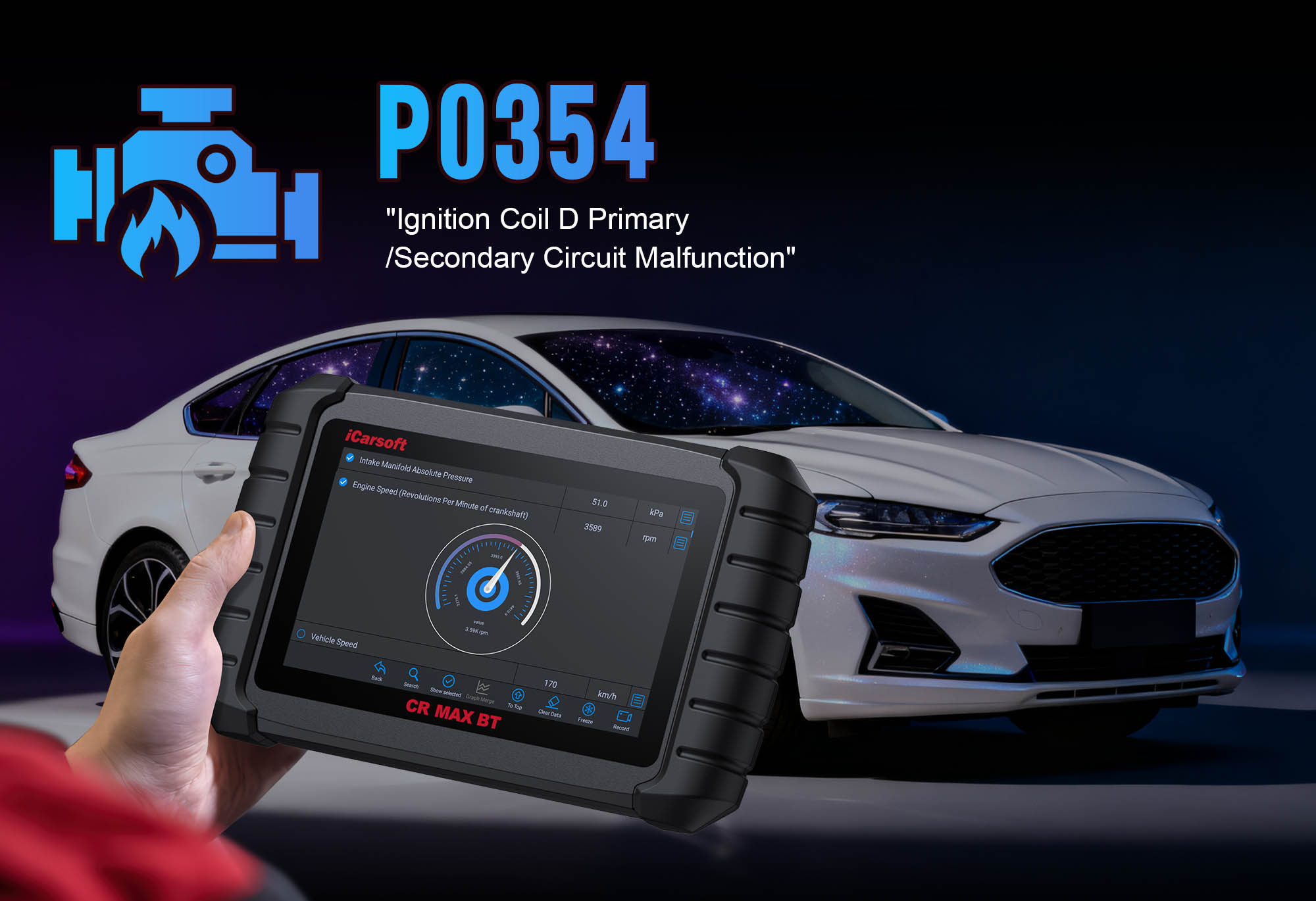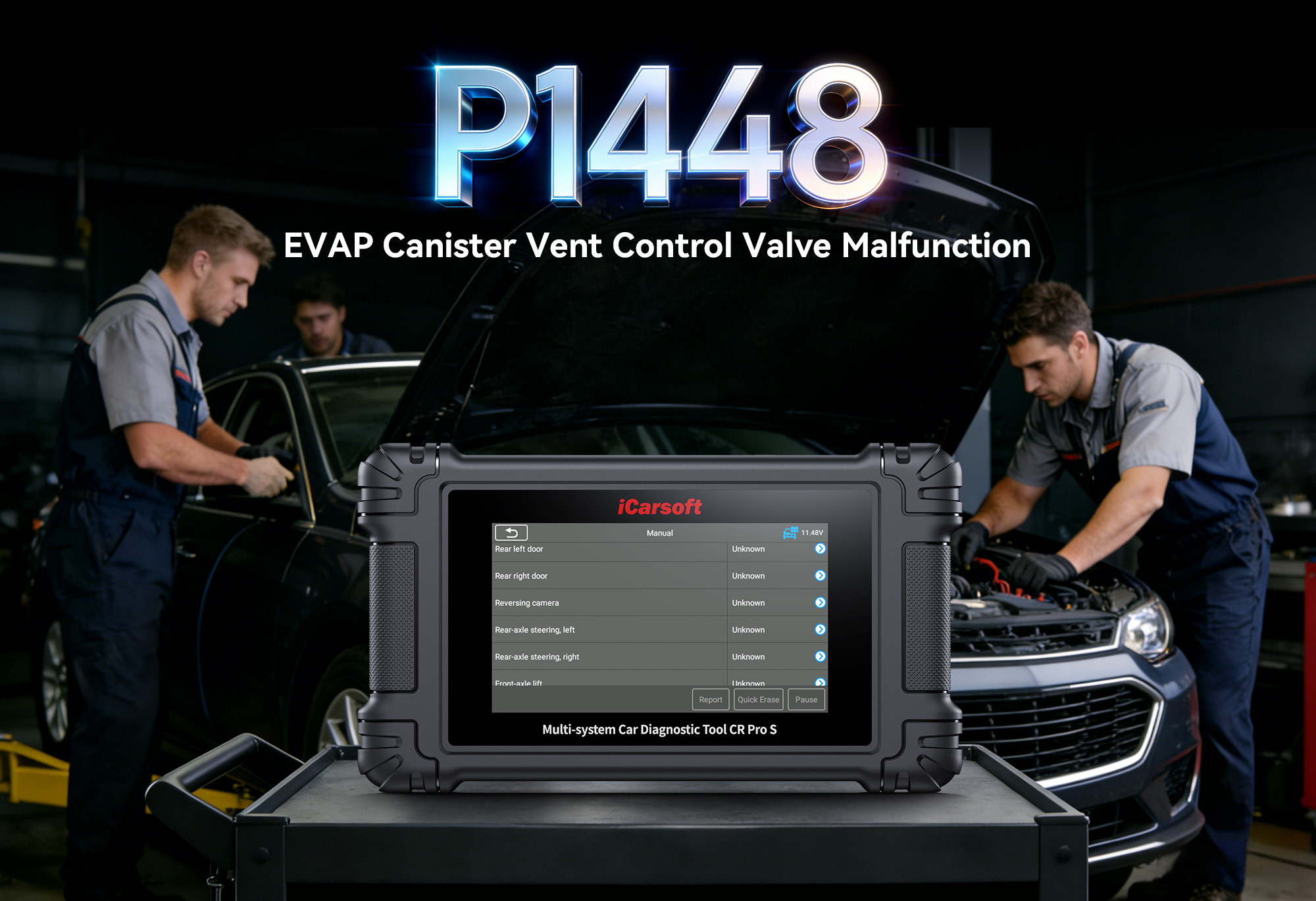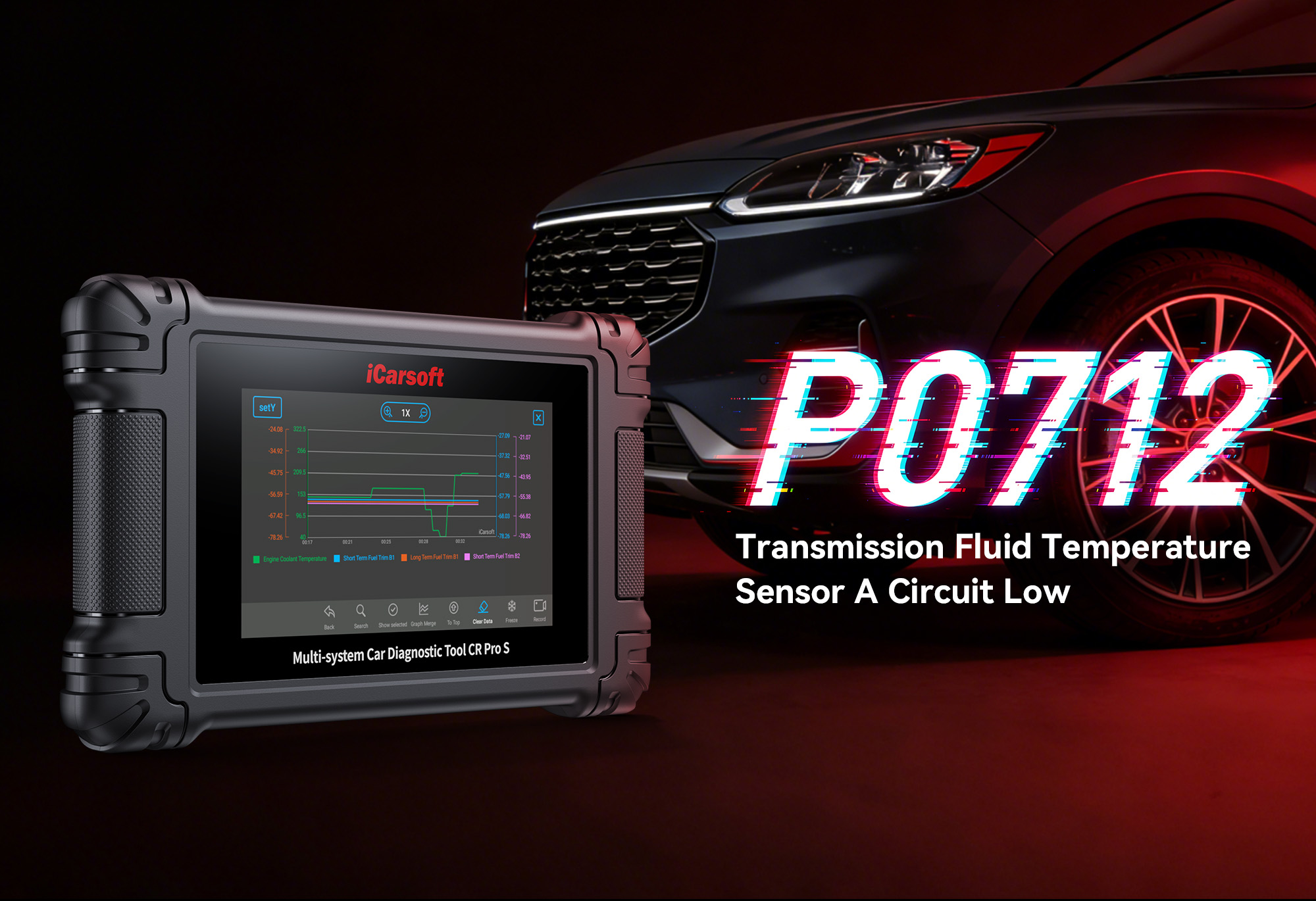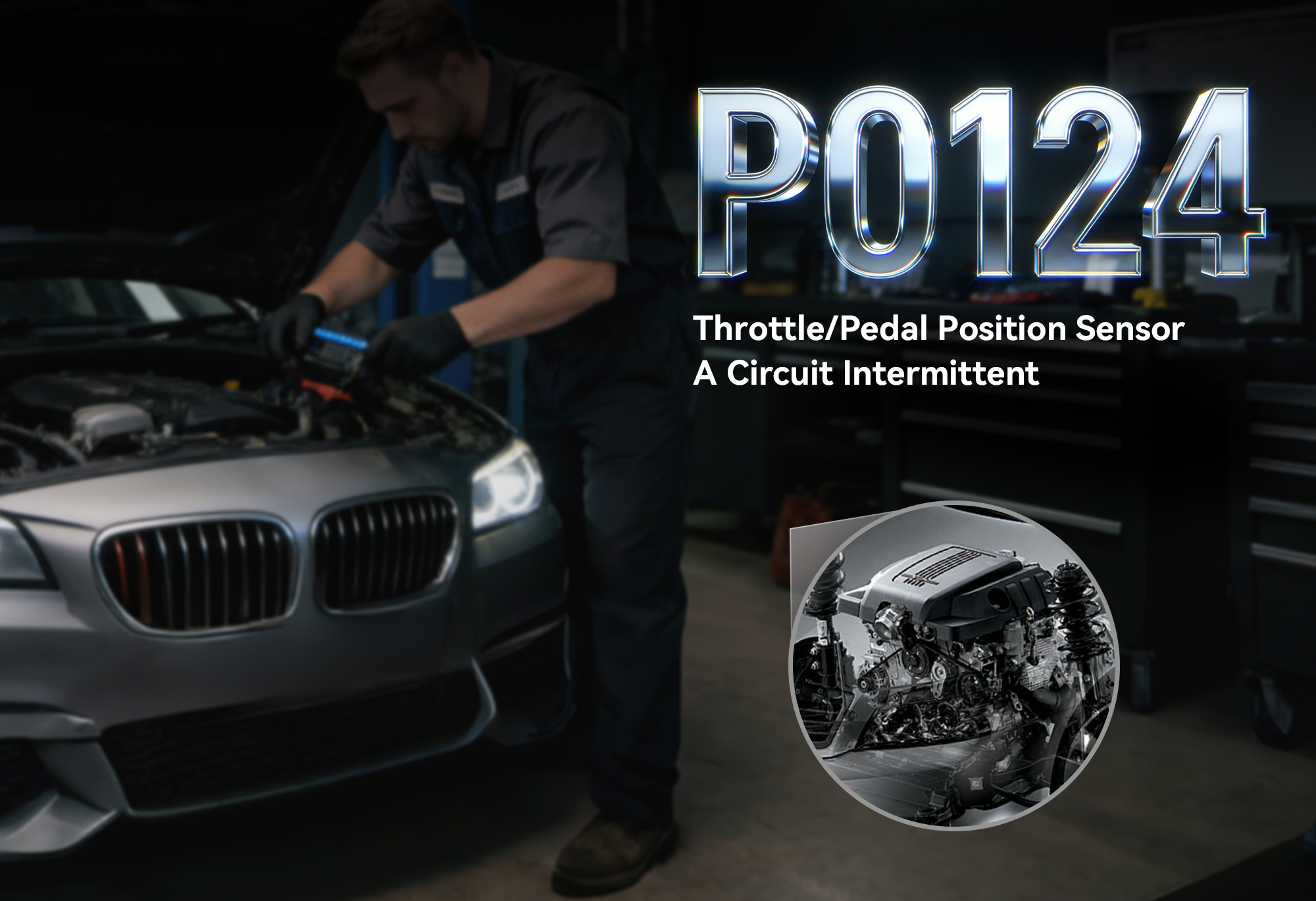Diagnose & Clear P0354 with iCarsoft CR MAX BT: Fix Ignition Coil "D" Primary/Secondary Circuit Malfunction
If your check engine light illuminates and you experience rough idling, hesitation during acceleration, or even engine misfires, a diagnostic scan will likely return P0354. This OBD-II code stands for "Ignition Coil 'D' Primary/Secondary Circuit Malfunction," indicating the Engine Control Module (ECM) has detected a fault in the electrical circuit of the ignition coil assigned to cylinder "D" (typically cylinder 4 in a 4-cylinder engine or cylinder 4 in a V6/V8 configuration).
Ignition coils convert the vehicle’s 12V electrical current into the high voltage (20,000–50,000V) needed to ignite the air-fuel mixture in the combustion chamber. Each coil (or coil pack) is assigned a specific cylinder, and a malfunction in coil "D" disrupts combustion in its paired cylinder—leading to misfires, reduced power, and increased emissions.
Basic scanners may only flag "ignition coil D fault" but can’t test coil resistance or isolate wiring issues. The iCarsoft CR MAX BT—with its coil resistance testing, circuit integrity checks, and cylinder balance analysis—solves this. Let’s explore how to diagnose and resolve P0354 using this advanced tool.
 iCarsoft CR MAX BT: Testing ignition coil "D" resistance to diagnose P0354 circuit malfunction
iCarsoft CR MAX BT: Testing ignition coil "D" resistance to diagnose P0354 circuit malfunction
Understanding P0354: Causes & Key Symptoms
A faulty ignition coil "D" or its circuit disrupts combustion in its paired cylinder, leading to distinct performance issues:
Key Symptoms of P0354
-
Check Engine Light: Illuminates when the ECM detects abnormal voltage, resistance, or no signal from ignition coil "D" for 2+ drive cycles.
-
Cylinder 4 Misfire: The engine shakes or vibrates, especially at idle or low speeds, as cylinder "D" fails to ignite fuel consistently.
-
Reduced Power & Acceleration: A non-functioning cylinder reduces overall engine output, causing hesitation or sluggishness during acceleration.
-
Increased Fuel Consumption: The ECM compensates for the misfire with a richer mixture, lowering MPG by 10–20%.
-
Catalytic Converter Damage Risk: Unburned fuel from the misfiring cylinder ignites in the converter, raising temperatures and risking premature failure.
-
Rough Idle: The engine may stall at stops due to uneven combustion from the non-functioning cylinder.
Common Causes of P0354
-
Faulty Ignition Coil "D": Internal electrical failure (e.g., a shorted primary winding or broken secondary winding) prevents the coil from generating high voltage.
-
Damaged Wiring or Connector: Frayed wires, corroded terminals, or loose plugs in the coil "D" circuit disrupt voltage flow to/from the ECM.
-
Failed Coil Driver in the ECM: A faulty transistor in the ECM that controls coil "D" prevents it from firing (rare but possible).
-
Water Intrusion: Moisture in the coil housing or connector (common in wet conditions) causes short circuits.
-
Overheating: Prolonged engine overheating can damage the coil’s windings, especially if mounted near the exhaust manifold.
-
Incorrect Coil Installation: A loose mounting bolt or poor ground connection disrupts the coil’s operation.
Why iCarsoft CR MAX BT Excels at Diagnosing P0354
The CR MAX BT outperforms basic tools with features tailored to ignition system diagnostics:
Ignition Coil Resistance Testing
Measures primary (12V) and secondary (high voltage) winding resistance for coil "D," comparing results to manufacturer specs.
Circuit Integrity Checks
Tests continuity, voltage, and ground connections in the coil "D" circuit to identify shorts, opens, or corrosion.
Cylinder Balance & Misfire Tracking
Logs misfire counts for cylinder "D" during idle and acceleration, confirming the coil’s role in the fault.
3D Component Diagrams
Preloaded schematics show the location of ignition coil "D" and its wiring path for 80+ makes (e.g., Toyota, Ford, Chevrolet, BMW).
Coil Driver Test
Sends a simulated signal to the ECM’s coil driver to rule out a faulty module (advanced feature for isolating rare ECM issues).
Freeze Frame Data
Captures conditions when P0354 was triggered (e.g., "RPM: 900, Load: 30%") to contextualize the fault.
Step-by-Step: Diagnose P0354 with iCarsoft CR MAX BT
-
Connect & Confirm the Code
Plug the CR MAX BT into your vehicle’s OBD-II port and pair it with your smartphone/tablet via the iCarsoft app (Bluetooth setup takes 30 seconds). Select your vehicle using Auto VIN Scan (reads VIN instantly) or manual entry (make/model/year/engine). Navigate to Engine > Fault Codes > Read Codes to confirm P0354. Tap Code Details for vehicle-specific insights (e.g., "Toyota: Ignition Coil 'D' (Cylinder 4) Circuit Voltage = 0V; Check Coil & Wiring").
-
Locate Ignition Coil "D"
Use the CR MAX BT to avoid confusion:
-
Go to Component Location > Engine > Ignition System > Ignition Coil 'D'.
-
The app displays a 3D diagram: Coil "D" is typically labeled or positioned to serve cylinder 4 (verify with the app’s cylinder numbering guide—e.g., "V6: Bank 1 = Cylinders 1-3, Bank 2 = Cylinders 4-6; Coil 'D' = Cylinder 4").
-
Analyze Live Misfire & Coil Data
Real-time data confirms coil "D" is the source of the issue:
-
Start the engine and let it idle for 5 minutes.
-
In the app, go to Engine > Live Data > Ignition System and monitor:
-
Cylinder 4 Misfire Count: Should remain at 0. Increasing counts = direct link to coil "D" failure.
-
Coil "D" Control Voltage: Normal = 9–14V (fluctuates as the ECM triggers the coil). 0V or steady 12V = circuit fault.
-
Engine Load & RPM: Misfires often worsen under load (e.g., acceleration), confirming the coil can’t handle increased demand.
-
Test Ignition Coil "D" Resistance
A faulty coil is the top cause of P0354—verify with the CR MAX BT:
-
Ensure the engine is off and cool. Disconnect the electrical connector from coil "D".
-
Navigate to Special Functions > Engine > Ignition Tests > Coil Resistance.
-
Follow the app’s guide to:
-
Measure primary resistance (between the coil’s power and control pins). Normal = 0.5–2.0 ohms (varies by manufacturer).
-
Measure secondary resistance (between the primary pins and the spark plug terminal). Normal = 8,000–15,000 ohms.
-
Out-of-range values (e.g., 0 ohms = short; infinite = open) confirm a faulty coil.
-
Inspect the Coil, Connector & Wiring
Physical issues often cause circuit faults—check with guidance from the CR MAX BT:
-
Test the Coil Circuit for Voltage & Ground
Electrical faults disrupt coil operation—verify with the CR MAX BT:
-
Power Supply Test: Turn the ignition to "On" (engine off). Use the app’s Multimeter Function to measure voltage at the coil’s power pin. Normal = 12V. 0V = blown fuse or broken power wire.
-
Ground Circuit Test: Measure resistance between the coil’s ground pin and the vehicle chassis. Normal = <1 ohm. High resistance = corroded ground—clean or repair.
-
Control Signal Test: With the engine running, use the app’s Oscilloscope Function to monitor the ECM’s control signal to coil "D". A healthy signal shows sharp voltage drops when the coil fires; no signal = ECM driver failure.
-
Swap Test (If Applicable)
For vehicles with identical coil designs, confirm the fault is with the coil, not the circuit:
-
Swap coil "D" with another coil (e.g., coil "C" for cylinder 3) using the app’s Coil Swap Guide.
-
Rescan with the CR MAX BT. If P0354 clears and a new code (e.g., P0353) appears, the original coil "D" is faulty.
-
Repair & Clear P0354
Fix the Root Cause:
-
Replace ignition coil "D" with an OEM or OE-equivalent part (check the app’s Part Lookup for compatibility).
-
Repair wiring faults: Replace frayed wires with heat-shrink connectors; secure loose connections.
-
Clean or replace a corroded connector—apply dielectric grease to prevent moisture damage.
-
Fix oil leaks (e.g., valve cover gasket) to protect the new coil from contamination.
Clear the Code: In the app, go to Engine > Fault Codes > Clear Codes to delete P0354.
-
Validate the Repair
Confirm the ignition coil and circuit work correctly:
-
Recheck live data—cylinder 4 misfire count should remain at 0.
-
Test drive for 15–20 minutes, including acceleration and idle, to verify smooth performance.
-
Monitor for improved fuel efficiency and no hesitation during high-load conditions (e.g., climbing hills).
-
Re-scan with the CR MAX BT: No P0354 recurrence = successful repair.
Preventing P0354 Recurrence
The CR MAX BT helps maintain reliable ignition system performance long-term:
-
Coil Maintenance: Use the app’s Service Reminder to inspect ignition coils every 30,000 miles for cracks, oil leaks, or corrosion.
-
Wiring Checks: Include coil connectors in annual underhood inspections—clean terminals and apply dielectric grease.
-
Spark Plug Replacement: Replace spark plugs every 60,000 miles (matching manufacturer specs) to prevent excessive load on ignition coils.
-
Regular Scans: Use the CR MAX BT’s Quick Scan monthly to monitor misfire counts and coil voltage, catching issues early.
Conclusion
P0354’s ignition coil "D" fault disrupts critical combustion in cylinder 4, but the iCarsoft CR MAX BT simplifies diagnosis with resistance testing, circuit checks, and misfire tracking. Whether replacing a coil, fixing wiring, or addressing corrosion, this tool ensures you resolve the root cause—restoring engine performance, fuel efficiency, and protecting the catalytic converter.
With the CR MAX BT, tackling "ignition coil circuit" faults becomes a precise process, keeping your engine’s ignition system reliable for every drive.

 iCarsoft CR MAX BT: Testing ignition coil "D" resistance to diagnose P0354 circuit malfunction
iCarsoft CR MAX BT: Testing ignition coil "D" resistance to diagnose P0354 circuit malfunction



